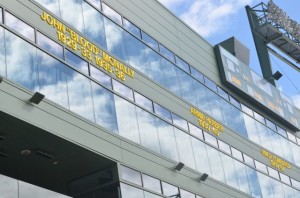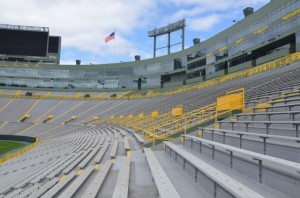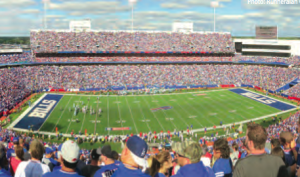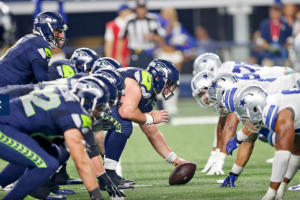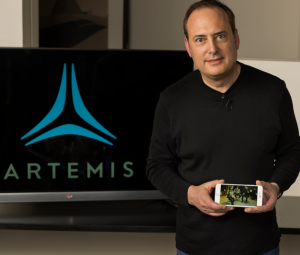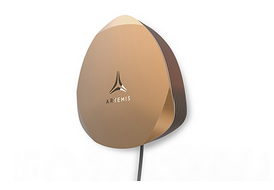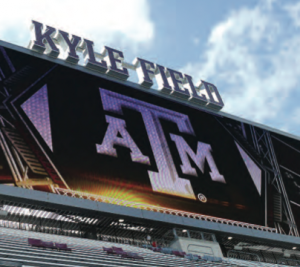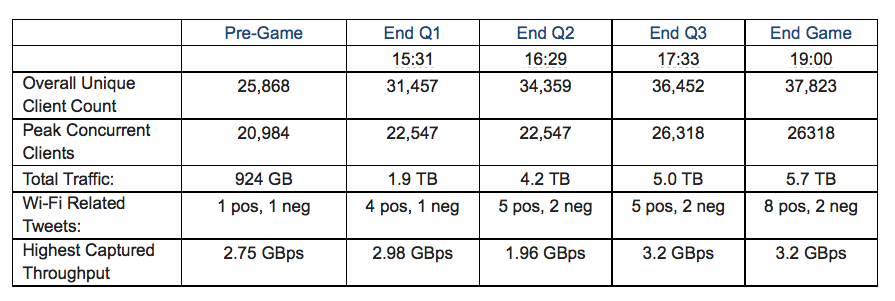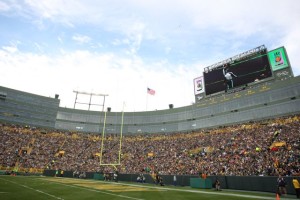
Lambeau Field, home of the Green Bay Packers, now has Wi-Fi for fans. All photos: Green Bay Packers (click on any photo for a larger image)
But do they think of those same Packers fans pulling out their iPhones and Samsungs to take selfies, and posting them to Instagram or Facebook? Maybe not so much.
The reality is, however, that in 2015, football fans in Green Bay are pretty much like fans anywhere else when it comes to wanting to use their mobile devices while at the game. So to make sure the Lambeau Field fan experience remains at the top of the league, the Packers teamed up with Extreme Networks and Verizon Wireless to bring a fan-facing Wi-Fi network to Lambeau this season, one that will likely be heavily used even at the risk of frostbitten fingers.
Editor’s note: The following profile is an excerpt from our most recent Stadium Tech Report, THE PRO FOOTBALL ISSUE. To get all the profiles in one place as well as our featured reports, interviews and analysis, download your free copy of the full report today.
Bringing the beast to the bowl
With more than 1,000 Wi-Fi access points installed throughout the stadium, the already-live network in Green Bay is the culmination of a 2-year project that started with an overhaul of the venue’s distributed antenna system (DAS), a task completed last year by Verizon, which acts as the DAS neutral host.
According to Wayne Wichlacz, director of information technology for the Packers, the second step of putting in and turning on a full-stadium Wi-Fi network required a lengthy search and qualification process, to ensure that the partners could deliver in the face of big challenges that exist in bringing wireless technology to a historic and legendary facility like Lambeau Field.
Even the most casual of NFL fans probably has some knowledge of Lambeau Field, which has known more than its share of history since opening in 1957. The glory years of the Packers of the 1960s, when coach Lombardi and quarterback Bart Starr won the first two Super Bowls, helped cement the Green Bay “Titletown” lore, and the famous “Ice Bowl” game of Dec. 31, 1967, between the Packers and the Dallas Cowboys, gave birth to the “Frozen Tundra” nickname for the big concrete circle on Lombardi Avenue.That big bowl, which has been added to significantly since its opening, now can seat 81,435 fans, making it the third-largest in NFL seating capacity, behind only AT&T Stadium in Dallas and MetLife Stadium in New Jersey. Though Lambeau Field previously had Wi-Fi networks for internal business purposes as well as for some suite and premium seating, bringing Wi-Fi to the full stadium was a task of a different magnitude, Wichlacz said.
“It’s a different beast to bring [Wi-Fi] to the bowl,” Wichlacz said.
The two big challenges for Wi-Fi deployment at Lambeau revolved around aesthetics and placements; as a historic and legendary structure, extreme care needed to be taken to make sure Wi-Fi gear placements didn’t detract from the visual experience and old-time charm. And just to make that first task tougher was the challenge of finding enough places for Wi-Fi APs in a facility that is mainly a big open bowl, without much overhang space for mounting.
And don’t forget about the large amount of metal-bench seating, which took away the opportunity to install under-the-seat APs.
“There’s just not a lot of levels [in Lambeau] for us to do things,” Wichlacz said. “It was a real installation challenge.”
After putting out an RFP that took all the necessary considerations into play, Wichlacz said the Packers evaluated proposals from all the major players in the large public venue Wi-Fi gear market before finally settling on Extreme, which has a solid history of NFL stadium deployments. After picking Extreme in the middle of last year, construction got underway in early 2015, Wichlacz said.
On the Extreme side, the company knew it was deploying on the NFL equivalent of hallowed ground, said Norman Rice, executive vice president for marketing at Extreme.
“A lot of additional work went into the design, in part because Lambeau Field is a historical site and such an iconic part of the landscape in the NFL,” Rice said. “We did a lot of unique stuff to get to what a Packers fan expects.”
Yellow paint and handrail enclosures
If most NFL fans are familiar with the Packers’ traditional gold and green colors, so now are the Wi-Fi deployment teams from Extreme and the Packers, who spent a good part of the deployment time painting APs to blend in to the stadium scenery. That meant green for antennas mounted up against certain building sections, and the bright yellow for the handrail antennas that Extreme used to help bring signals down into the rows of the bowl.
“We did a lot of unique stuff,” said Extreme’s Rice. “There are some pretty cool enclosures, where the yellow blends right into the walls.”
“If you’re looking for it, you can probably find it,” said Wichlacz of the painted antennas. “But it blends in pretty good.”
To gain some important real estate for wireless components, the Packers and their partners actually relocated the team’s signage listing the names of Packers inducted into the Pro Football Hall of Fame, raising it up one level and using it as a way to mask Wi-Fi and DAS gear.“You can actually see the [names] better now, and we were able to put Wi-Fi and DAS antennas in there,” Rice said. “It’s a nice piece of work.”
All the aesthetic work had to also be blended with the technical requirements of antenna placement, to ensure good coverage without interference. Jacque Vallier, the Illinois/Wisconsin regional executive director of network for Verizon Wireless, compared Lambeau Field to the older college stadiums, the large concrete bowls that are among the hardest structures to bring services to.
“It definitely was an RF and engineering challenge,” said Vallier of the DAS design. Vallier said that AT&T is currently a client on the Verizon neutral DAS, which uses CommScope gear. The DAS also covers the parking lot areas outside Lambeau Field, where tailgating is a high art.
Separate SSID for Verizon Customers
Like other NFL deployments where Verizon is a major sponsor, the Lambeau Field Wi-Fi network will have two separate SSIDs, one reserved for Verizon Wireless customers, and the other for everyone else. According to Verizon’s Vallier, the Verizon subscribers will have access to about 40 percent of the Wi-Fi bandwidth, with some devices supporting automatic authentication to the service. Verizon and Extreme have a similar deployment at CenturyLink Field in Seattle.
According to Extreme’s Rice, the mix of network usage is tuned to ensure that all fans who are seeking Wi-Fi connectivity will have more than enough bandwidth. Both the Verizon-specific network and the public network (which run off the same Wi-Fi gear) will meet or exceed the NFL’s Wi-Fi requirements, he said.
“It’s done to ensure Verizon customers have a good connection, but not at the expense of other users,” Rice said of the split SSIDs. Verizon, which is a big sponsor of the NFL in general (including its $1 billion payment for live-action rights on smartphones for its NFL Mobile app), is also a sponsor of Wi-Fi networks at NFL stadiums in Detroit and Denver.
As a final Green Bay touch, the Extreme “Wi-Fi coaches” program, which trains people who wander the stands on game days helping fans to get connected to the network, will use area high school students as “coaches,” fitting right in with the family-friendly atmosphere that the Packers are famous for.
“It’s really going to be cool to tie the coaches program to the community through the schools,” Extreme’s Rice said. “It’s great fun to be part of that.”
Can’t test the network until the stadium’s full
When it comes to large public venue deployments, there is the Wi-Fi network you design on paper, the network you build, and then the network that happens when the venue fills up with users. Thanks to the mid-year completion of the Lambeau Field network, Wichlacz and his IT team were able to test the Wi-Fi network in several “beta” situations, which included a Kenny Chesney concert and a Brett Favre celebration that filled the bowl.
“Testing network theory versus having people [using the network] is night and day,” Wichlacz said. Live tests, he said, “give the engineering folks the ability to test and tweak. It’s definitely helpful to have those events.”And if there was any doubt that fans at Lambeau Field want to use their devices, Verizon’s Vallier can help end the debate.
“During the second preseason game we saw more than 500 gigabytes of traffic [on the DAS],” Vallier said, noting that totals so far are pointing to be one-and-a-half times bigger than in 2014.
And though Wichlacz is reticent to provide exact Wi-Fi data usage numbers, Extreme’s Rice said one of the Packers’ preseason games recorded “one of the highest [Wi-Fi usage] numbers we’ve ever seen.”
That figure seems to answer a question Rice said the team had asked itself earlier, about whether or not the Green Bay Packers and their fans needed stadium Wi-Fi. “There was a time when they [the Packers] had a big question, about if it mattered,” Rice said. Now that the Wi-Fi network is in, he said, “it’s amazing to see how much people use it.”
Wichlacz noted that Packers fans may not need to worry about frozen fingers, since the team has more home games earlier in the season this year. But he also remembers Verizon stats from the DAS last season that showed usage didn’t go down that much when the temperature got cold.
So – if you make it to Lambeau Field from now on, make sure you soak in the atmosphere and if you care to, share it with the world via Wi-Fi – something you can do now with ease thanks to the hard work from the Packers and their partners.
“For our whole team here, it’s been a labor of love,” Wichlacz said. “We spent a lot of hours working on this. We’re excited to launch it, and correct it as we go.”
